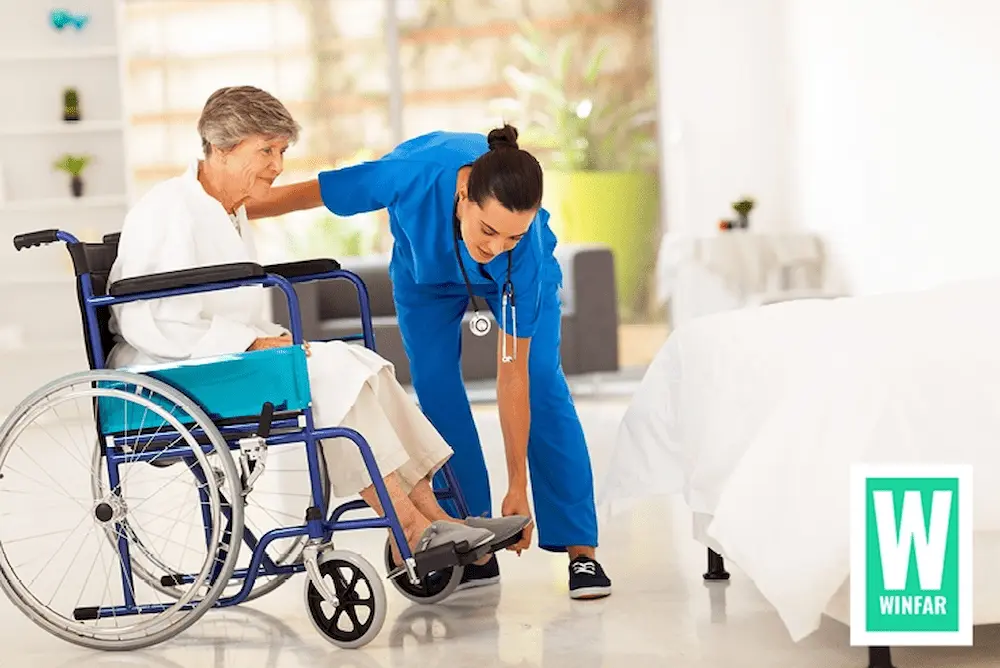Taking care of a spouse or family member at home is never easy. It can be both emotionally and physically demanding.
As a home caregiver, one of the trickiest tasks you will face during the course of the day is the transfer.
The average wheelchair user spends about 10 hours per day in the wheelchair and performs about 8 transfers a day. So, it’s a process you want to make as simple, seamlesss, and safe as possible.
What is a transfer?
A transfer most often speaks into the moving of a person from the bed to a wheelchair or visa versa. But, it can also include the moving of the ‘patient’ from a wheelchair to the toilet, or from a wheelchair into a car.
The Pivot Transfer
The 3 most commonly used transfer techniques are pivot transfers, scoot transfers and/or slide board transfers. In this article, we will focus on the pivot transfer.
The pivot transfer (also known as an assisted transfer) is one of the most commonly used transfer techniques. It takes advantage of the strength and stability of a caregiver to transfer someone from one point to another, most commonly from the wheelchair to the toilet.
Assisted transfers are useful when wheelchair users can move partially with support from a caregiver. It can be completed with anywhere from minimal assistance to total assistance from a caregiver. It’s simple, “safe” and effective, but is not considered a long-term solution as it heavily relies on the strength of the caregiver. If you don’t use safe lifting and transfer techniques, it’s easy to hurt yourself or your older adult.
Why is it so important to do transfers correctly?
Regardless of the nature of the transfer, meeting the physical demands of lifting, turning, and transferring a person from one surface to another can put both the patient and caregiver at risk of injury.
As caregiver, you can hurt a bedridden person, tearing or bruising the skin – and/or worse, breaking a bone. And similarly, you risk injuring yourself. It is therefore important that a transfer is done correctly, regardless of the method.
Regardless of the lifting technique used there are some general guidelines that should be adhered to, to ensure the safe lifting and transferring of patients. These guidelines are applicable across all techniques, and specifically aimed at those caregivers who do not have any additional aids.
Transfer aids
It is recommended that you invest in a transfer aid, as it will make both your life and that of the person in your care, significantly safer and easier. Not all aids need to cost a fortune. A simple gait belt or sliding board is all you need, but they will make a significant difference to the ease of the process for both you and your patient.
A gait belt can be used with any and all transfer methods. And is, as its name suggests a belt, which basically provides a firm grip for the caregiver. Meaning the caregiver grips the belt for the purpose of transfer rather than clasping their hands behind the patients back.
Safe transfer techniques
Below are a few essential tips to ensure a safe transfer for both parties.
BEFORE YOU START:
Before attempting a transfer to or from a wheelchair, it’s essential to be prepared. Poor preparation increases the risk that something will go wrong during a transfer, resulting in a slip, fall, or injury to the caregiver.
- Be clear in your mind beforehand, of the steps you need to follow before you execute.
- If you are not able to support the patient by yourself, ask for help. Be honest with yourself in this regard. Don’t hope for the best and then find out halfway through you were mistaken. You will injure yourself and the patient.
- When you are ready, explain the steps to the patient so s/he is clear as to what you plan to do and how. And, can then assist you as much as possible.
- Only move them when they are ready
- If the patient starts to fall during the transfer, lower the person to the nearest flat surface, bed, chair or floor.
YOUR BODY:
Lifting a patient can be hard on your back. So, to reduce the risk of a back injury, follow these simple steps:
- Always keep your knees bent, your back straight, and your feet flat on the floor.
- Keep your feet shoulder-width apart to maintain your balance.
Do not leave your feet in place and twist your body at the waist during a transfer. Instead, bend your knees and move from your hips. - Avoid twisting your body. Use your core muscles – not your back.
- Use your body’s momentum to move the person. Keep your back curved rather than holding it straight.
- Always keep the person being moved as close to your body as possible. But do not let them hold or hug your neck while you are moving them.
YOUR ENVIRONMENT:
- Make sure the chair is as close to the bed – and you, as possible, so the distance of transfer is as short as possible.
- Angle the wheelchair parallel to the bed. So the foot of the wheelchair faces the same direction as the foot of the bed. Ensure no steps need to be taken between the 2 surfaces.
- Lock the wheelchair, so it cannot move. And move the footrests out of the way.
- Move the wheelchair “feet” out of the way. The wheelchair’s footrests should be in the upright position so that the user’s feet can get as close as possible to the seat without becoming tangled.
- Make sure any loose rugs are out of the way.
How to move a patient from the bed to the wheelchair, using a pivot transfer
1. Helping your patient to sit, or rise to a seated position
Before transferring into the wheelchair, the patient must be sitting. If the person is not strong enough to push up with his or her hands to a sitting position, you need to get the patient raised and ready in a seated position. To do this:
- Help the patient turn over onto his or her side, facing you.
- Put an arm under the patient’s upper back, with your hand supporting the shoulder.
- Put your other hand behind the knees.
- Swing their legs over the edge of the bed, and at the same time use their momentum to pivot them into a sitting position
- Move the patient to the edge of the bed and if the bed is height adjustable, lower the bed so the patient’s feet are touching the ground.
2. Pivot transfer from a seated position into the wheelchair
Now, from the seated position, assist your patient to get into the chair:
- Position the person’s feet on the floor, slightly apart.
- Your feet should be shoulder-width apart with your knees bent.
- Place the patient’s outside leg (the one farthest from the wheelchair) between your knees for support. Bend your knees and keep your back straight.
- Face the person. Place their hands flat on the bed to help them push up or on your shoulders.
- Position yourself in front of the wheelchair user with a firm grip on the gait belt. If you are not using a gait belt, put your arms around the patient’s chest and clasp your hands behind his or her back.
- Count to three and slowly stand up. Use your legs to lift.
To complete the transfer, the person should lean forward over their feet, use their hands to push from the surface they are sitting on, swing their bottom around to the adjacent surface, and slowly sit back down.
To accomplish this:
- Support the leg farthest from the wheelchair between your legs, Hold the person close to you, lean back, shift your weight, and lift.
- As the patient bends toward you, bend your knees and pivot towards the chair. and slowly lower the patient into the back of the chair.
- Pivot towards the wheelchair, moving your feet so your back is aligned with your hips.
- The patient should help support their weight on their good leg during the transfer.
- As the wheelchair user lifts and pivots themselves, support their efforts with the gait belt. Be careful not to haul them up—a gait belt is not a lifting device.
- Once the patient’s legs are touching the seat of the wheelchair, bend your knees to lower the patient into the seat. At the same time, ask the patient to reach for the wheelchair armrest.
- Ensure the wheelchair user is appropriately positioned in the wheelchair before letting go of the gait belt.
- Make sure the person has both hands on the arms of the chair before you lower him or her down
3. When the transfer is complete:
- Help the person sit with their back resting against the back of the chair, ensuring they are as comfortable as possible.
HOW TO: Watch the below 7-minute video for how to correctly and safely pivot transfer a patient from bed to wheelchair.
DISCLAIMER: This website does not provide medical advice. This information, including text, graphics, images, and other material contained on this website is for information purposes only. No material on this site is intended to be a substitute for professional medical advice, diagnosis, or treatment. Always seek the advice of your physician or other qualified health care provider with any questions you may have regarding a medical condition or treatment before undertaking a new health regime, and never disregard professional medical advice or delay in seeking it because of something you have read on this website.
Sources:
* https://www.myshepherdconnection.org/sci/transfers/pivot-transfer
* https://orthoinfo.aaos.org/en/staying-healthy/lifting-techniques-for-home-caregivers
* https://www.transfermaster.com/how-to-transfer-from-wheelchair-to-home-hospital-bed-and-back
* herdconnection.org/sci/transfers/pivot-bed

